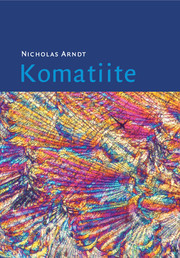Book contents
- Frontmatter
- Contents
- Preface
- Part I Background information – description of the field characteristics, mineralogy and geochemistry of komatiites
- 1 A brief history of komatiite studies and a discussion of komatiite nomenclature
- 2 Brief descriptions of six classic komatiite occurrences
- 3 Field characteristics, textures and structures
- 4 Mineralogy
- 5 Geochemistry
- 6 Isotopic compositions of komatiites
- 7 Experimental petrology
- Part II Interpretation – the manner of emplacement, the origin and the tectonic setting of komatiites
- References
- General index
- Localities
- Plate section
7 - Experimental petrology
from Part I - Background information – description of the field characteristics, mineralogy and geochemistry of komatiites
Published online by Cambridge University Press: 27 August 2009
- Frontmatter
- Contents
- Preface
- Part I Background information – description of the field characteristics, mineralogy and geochemistry of komatiites
- 1 A brief history of komatiite studies and a discussion of komatiite nomenclature
- 2 Brief descriptions of six classic komatiite occurrences
- 3 Field characteristics, textures and structures
- 4 Mineralogy
- 5 Geochemistry
- 6 Isotopic compositions of komatiites
- 7 Experimental petrology
- Part II Interpretation – the manner of emplacement, the origin and the tectonic setting of komatiites
- References
- General index
- Localities
- Plate section
Summary
Introduction
Experimental work on komatiites has proceeded along three main lines. The first involved phase relation studies performed between 1975 and about 1984. These experiments, which were carried out at relatively low pressures, from 1 atm to about 4 GPa, were useful and provided valuable information about phase relationships and element partitioning, but they were not particularly exciting: they merely showed that komatiites behaved as might be expected – as a tholeiitic basalt containing 30–50% extra olivine.
More interesting is the second series of experiments, which started around 1984 and involved more extreme conditions. These experiments were carried out with ultra-high-pressure multi-anvil apparatuses and with shock-wave techniques, at pressures between ∼4 and 20 GPa and temperatures from 1500 to 2000 ℃, conditions corresponding to those in the deep interior of the Earth's mantle. It was apparent from an early stage of komatiite investigation that certain characteristics of komatiites – their high eruption temperatures and geochemical signature of garnet depletion – are best explained by melting deep in the mantle, and only such experiments are able to provide the information necessary to answer critical questions of komatiite petrogenesis.
The third line involved rapid-cooling experiments designed to understand the conditions in which spinifex and other textures form during the crystallization of komatiite flows. The more recent experiments of this type have succeeded in reproducing these textures and, when combined with fluid dynamic modelling, have provided valuable constraints on the mechanisms of komatiite eruption and solidification.
- Type
- Chapter
- Information
- Komatiite , pp. 202 - 232Publisher: Cambridge University PressPrint publication year: 2008



